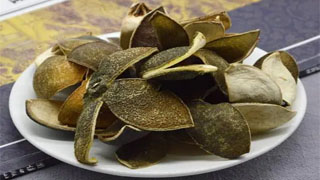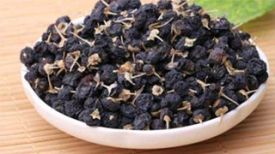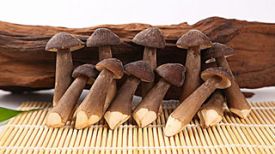
1. Alias
Green orange peel, green orange peel.
2. Plant morphology
Evergreen small trees or shrubs, 3-4 meters high. Branches are delicate, with or without thorns. Single compound leaves alternate; The petiole is 0.5-1.5 millimeters long, with indistinct leaf wings and a joint at the top; Leaves lanceolate or elliptical, 4-11 cm long, 1.5-4 cm wide, apex gradually pointed, slightly concave, base wedge-shaped, entire margin or with indistinct wavy blunt serrations, with translucent oil gland dots. Flowers grow singly or in pairs at the ends of branches or leaf axils, with flower stalks; Calyx cup-shaped, 5-lobed, lobes triangular; Petals 5, long elliptical, 1-1.5 cm long, white or light red, rolled outward; There are 15-25 stamens, varying in length. The filaments are often 3-5 fused and are equal or slightly longer than the stigma; Pistil 1, ovary round, stigma head shaped. Citrus fruits are nearly round or flattened, with a transverse diameter of 4-7 centimeters, and are red, vermilion, yellow, or orange yellow in color; The skin is thin and loose, easy to peel off, and the pulp has 7-12 petals, making it easy to separate. The seeds are oval in shape, pointed at one end, white, with several to dozens of seeds, or none, the embryo is dark green, and the cotyledons are light green. The flowering period is from March to April, and the fruit ripening period is from October to December.
3. Origin distribution
Cultivated in hills, low mountains, Rivers and Lakes or plains. In provinces and regions such as Shaanxi, Hubei, Hunan, Guangdong, Guangxi, Jiangsu, Zhejiang, Anhui, Fujian, Jiangxi, Taiwan, Yunnan, Guizhou, and Sichuan.
4. Harvesting and processing
Collect young fruits from May to June, dry them in the sun, and commonly refer to them as "green skin"; Harvesting immature fruits from July to August, longitudinally cutting them into four petals from the skin to the base, removing all petals, and drying them in the sun, commonly known as "Four Flower Green Skin".
5. Characteristics of medicinal herbs
Four flowered green skin: The skin is divided into four lobes, which are elongated and elliptical in shape, measuring 4-6 centimeters in length and 0.1-0.2 centimeters in thickness. The outer surface is gray green or black green, with many oil chambers densely packed; The inner surface is white or yellow white, rough, with yellow white or yellow brown small tendons attached. Slightly hard in texture, easy to break, with 1-2 rows of oil chambers on the outer edge of the cross-section. Fragrant aroma, bitter and spicy taste. Qingpi: spherical in shape, with a diameter of 0.5-2 centimeters. The surface is gray green or black green, slightly rough, with fine concave oil chambers, slightly protruding column bases at the top, and circular fruit stem marks at the base. Hard in texture, with yellow white or light yellow brown skin on the cross-section. It is 0.1-0.2 cm thick and has 1-2 rows of oil chambers on the outer edge. 8-10 petals of flesh sac, light brown in color. It has a fragrant aroma and a sour, bitter, and pungent taste.
6. Sexual Taste Returning to the Classics
Warm in nature, bitter and pungent in taste. Return to the liver meridian, gallbladder meridian, and stomach meridian.
7. Effect and Function
Soothing the liver and breaking qi, eliminating accumulation and resolving stagnation. It belongs to the category of Qi regulating medicine.
8. Clinical application
Take 3-10 grams orally in decoction, or in pills or powder. Used to treat chest and rib pain, hernia pain, breast fetish, breast abscess, food accumulation and qi stagnation, and abdominal distension and pain.
9. Pharmacological research
Adjust gastrointestinal function; Dispelling phlegm and relieving asthma; Choleretic; Liver protection; Anti shock; It has a positive effect on the excitability, conductivity, contractility, and autonomy of the myocardium.
10. Chemical composition
It mainly contains hesperidin, levosinomenine acetate, aspartic acid, cysteine, leucine, proline, etc. The dried and mature peel of Camellia sinensis contains 3.541% volatile oil, with limonene being the main component.
11. Usage taboos
Those with Qi deficiency should take it with caution.
12. Compatibility prescription
① For those who treat liver qi disharmony and rib pain that is as sharp as a blow: 240 grams of green skin (stir fried with alcohol), 120 grams of white mustard seed and Su Zi each, and 90 grams of gentian grass and Angelica sinensis tail each. At the end of it all. Take 9 grams each morning and evening, and adjust the leek decoction. ("Bencao Huiyan" cites "Fangmai Zhengtong")
② Due to long-term accumulation of depression, the breast has nuclei like fingers, which are painless and itchy. It can develop into a abscess in 5-7 years and is called breast cancer: 12 grams of green skin. Drink one and a half cups of water, fry one cup, slowly take it, take it daily, or drink it with alcohol. (The Compendium cites the Danxi Formula)
③ Treatment for primary breast abscess: 2.4 grams each of Qingpi (removing pulp), pangolin (stir fried), Bai Zhi, licorice, and Fritillaria. Above is fine powder. Warm the wine and adjust it for consumption. (Qingpi Powder from Selected Selections of Yangke)
④ Treatment for hernia: green skin (stir fried yellow), fennel (stir fried yellow). At the end, mix with hollow wine. (Zhong Miao Xian Fang leans towards Qi Fang)
⑤ For those who have been suffering from chronic pain in the heart and stomach and have extreme pain when eating rice soup: 15g of green skin, 9g of Xuanhusuo (stir fried with vinegar), 3g of licorice, and three jujubes. Boil it in water. ("Bencao Huiyan" cites "Fangmai Zhengtong")
⊙ The content of the article is for clinical reference only. Non TCM professionals are not allowed to test drugs.


